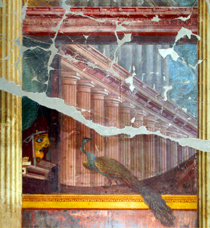 1
1The Mirrored Image - Phenomenological Painting
The new visual-discourse ushered in by the Second Style was experienced symbolically and phenomenologically. This is exemplified by the many instances in which the top of the pictorial wall is located at eye-level, thus inviting the viewer to physically and conceptually engage with the images that appear beyond it (fig.1). Other pictorial and physical coincidences relating to actual and depicted objects such as doors, windows, architraves, niches, arches, standing candelabra, curtains and food imagery also reinforce the phenomenological and symbolic nature of the paintings (fig.2&3). Much of the imagery associated with this new spatial form of painting consisted of buildings or spaces that had religious or metaphysical connotations, such as temples, shrines, sanctuaries or sacro-idyllic groves. These were depicted beyond barrier motifs such as walls, closed or semi-closed curtains, doors, gates and propylaea (temple porches), all of which made the images beyond them appear tantalisingly real and yet physically inaccessible (fig.4). From both a phenomenological and a psychological point of view these compositions appear to locate the viewer physically and metaphorically outside of the painting and the tantalising glimpses of a world beyond the pictorial barriers reinforced the viewer’s sense of exclusion. This paradoxically placed the viewer ‘outside’ the wall-painting whilst in reality being ‘inside’ the room.
Another layer of spatial complexity was added to this already heady mix of real and virtual realities in the form of mirroring. Not only did the walls appear to dissolve into distant vistas they also mirrored each other on opposing walls. In other words the same compositions, but with minor iconic differences, were positioned opposite each other. Bedroom M in the Villa of P. Fannius Synistor is a typical example (fig.5). Both of the lateral walls have the same general composition and only vary in terms of details relating to divinities and their symbolic attributes. Mirrored compositions such as these not only created symmetry within the room, but also placed the viewer in an ambiguous viewing position. The barrier motifs constituted major recurring compositional features that denoted literal exclusion from the painting’s architecturally defined space. In contrast, the compositional mirroring that occurred on opposite walls located the viewer in a space between both paintings, partially defined by the room itself and the painting’s iconography.
Ambiguity relating to location was not just confined to the viewer. Mirroring combined with votive iconography suggests that the wall-paintings may have signified an entrance into a metaphysical world and at the same time an exit from that world into the physical realm of the viewer. Even more challenging is the thesis that in the mind of the Roman viewer these paintings represented more than just 'conceptual' entrances and exits. The many instances of ritualised forms of worship found in the paintings, strongly suggests that they were more than just passive evocations of metaphysical or sublime worlds. If correct, then the house not only resembled a sanctuary but also functioned as one. The French Art Historian Gilbert Picard unequivocally concluded this to be the case.
 1
1
|